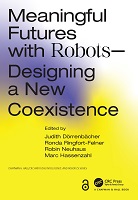Chapter 1 Towards Designing Meaningful Relationships with Robots
Proposal review
| dc.contributor.author | Dörrenbächer, Judith | |
| dc.contributor.author | Hassenzahl, Marc | |
| dc.contributor.author | Neuhaus, Robin | |
| dc.contributor.author | Ringfort-Felner, Ronda | |
| dc.date.accessioned | 2022-11-16T10:11:41Z | |
| dc.date.available | 2022-11-16T10:11:41Z | |
| dc.date.issued | 2023 | |
| dc.identifier.uri | https://library.oapen.org/handle/20.500.12657/59255 | |
| dc.description.abstract | Social robots are on the brink of entering our lives. However, little knowledge is available about how best to design them. This introductory chapter discusses the real-life social robots of the present as well as of possible futures—without, of course, forgetting the history of robots and their origins in fiction. From a design perspective, robots are promising and challenging. They suggest a technological other (“otherware”). Unlike conventional technologies that directly extend the physical and cognitive abilities of their users, robots engage in social exchange with humans. The authors present an overview of possible starting points for designing meaningful relationships with robots. Recurring themes are contextualized and cross cut, e.g., the influence of science fiction on robot design is discussed and the strategy of anthropomorphization is called into question. The authors respond to these relevant issues by arguing for robots with hybrid forms and unique “superpowers”. They present a new model for human-robot interaction, establishing three different kinds of interactions in terms of the meaning conveyed by robots to humans (delegating, cooperating, and socializing). Rather than imitating and thus replacing humans or animals, the authors conclude, robots should invite their own particular ways of being with us. | en_US |
| dc.language | English | en_US |
| dc.subject.classification | thema EDItEUR::U Computing and Information Technology | en_US |
| dc.subject.classification | thema EDItEUR::T Technology, Engineering, Agriculture, Industrial processes::TJ Electronics and communications engineering::TJF Electronics engineering::TJFM Automatic control engineering::TJFM1 Robotics | en_US |
| dc.subject.classification | thema EDItEUR::U Computing and Information Technology::UY Computer science::UYZ Human–computer interaction | en_US |
| dc.subject.other | a, aI, Coexistence, Designing, Dorrenbacher, Dörrenbächer, et, Felner, Futures, Hassenzahl, Judith, Marc, Meaningful, Neuhaus, New, Ringfort, Robin, Robots, Ronda | en_US |
| dc.title | Chapter 1 Towards Designing Meaningful Relationships with Robots | en_US |
| dc.type | chapter | |
| oapen.identifier.doi | 10.1201/9781003287445-1 | en_US |
| oapen.relation.isPublishedBy | 7b3c7b10-5b1e-40b3-860e-c6dd5197f0bb | en_US |
| oapen.relation.isPartOfBook | 17bfd2cb-2e5a-4b89-8f97-bb379c40c420 | en_US |
| oapen.relation.isbn | 9781032262673 | en_US |
| oapen.relation.isbn | 9781032246482 | en_US |
| oapen.imprint | CRC Press | en_US |
| oapen.pages | 27 | en_US |
| peerreview.anonymity | Single-anonymised | |
| peerreview.id | bc80075c-96cc-4740-a9f3-a234bc2598f1 | |
| peerreview.open.review | No | |
| peerreview.publish.responsibility | Publisher | |
| peerreview.review.stage | Pre-publication | |
| peerreview.review.type | Proposal | |
| peerreview.reviewer.type | Internal editor | |
| peerreview.reviewer.type | External peer reviewer | |
| peerreview.title | Proposal review | |
| oapen.review.comments | Taylor & Francis open access titles are reviewed as a minimum at proposal stage by at least two external peer reviewers and an internal editor (additional reviews may be sought and additional content reviewed as required). |

